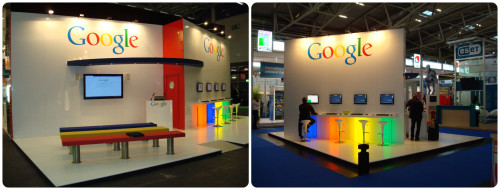SIX WAYS TO MAKE YOUR EXHIBITION STANDS ECO-FRIENDLY
SIX WAYS TO MAKE YOUR EXHIBITION STANDS ECO-FRIENDLY
By RICHARD EDWARDS, QUATREUS LTD
If you’ve ever exhibited at a show you will know they are a fantastic way of connecting face-to-face with a huge and highly targeted audience. You will also be aware of the high cost of building a stand and hiring the floor space. What’s more, anyone who has seen the skip at the back of an exhibition or trade show will be disgusted by the amount of material that is dumped after the show; materials that are just going to find their way into ever-growing landfill.
But exhibitions can be both economical and eco-friendly.
It doesn’t require you to scale back your vision for an impressive and eye-catching stand, you don’t have to skimp on materials, and you don’t have to blow the budget.. All it requires is a little planning. Here are six top tips to help you build an economical and environmentally friendly stand;
Tip 1: Reduce and reuse
Two cornerstones of environmental sustainability are the ability to reduce the amount of materials you use and reuse as much as possible again in the future.
If you exhibit at least once a year, reusable stand components are a prudent investment. Often components used in exhibition stands are more standardised than you might think, which means that with reusable modular or bespoke components, specifically designed to fit together in a number of ways, you can adapt and change your stand for each event without having to re-order an entirely new stand each time.
This cuts down on the amount you throw away at the end of each exhibition, making your activities more eco-friendly. On the financial side, reusable components mean you can invest your marketing budget safe in the knowledge that with a few tweaks, a different layout, and new graphics you can have a completely fresh stand for very little cost.
There are many reusable, modular stand structures which can be used multiple times to reduce cost and waste in the long-term, and deliver an impressive and high-impact stand without compromising on cost and sustainability.
If you know that you will only use an item once, then consider hiring it rather than buying it. By hiring you are effectively re-using the item and keeping it out of landfill.
Tip 2: Plan your design with the future in mind
If you are attending a number of exhibitions within a short space of time, or you’re planning a roadshow, reusing your stand for each event would be ideal. But the problem for the designer is that each event will have a different floor space, different restrictions and will need to access different utilities’ points. Designing one stand that will work perfectly in every space is challenging.
However, if you think of your stand as a series of individual modular components, it is easier to design something that can be adapted to each exhibition space. With careful design planning, components can slot together in myriad ways allowing you to keep the overall look and feel of your stand while still achieving something quite spectacular.
For example, the two stands below, both designed and supplied by Quatreus, demonstrate this in practice. The one on the left is from the Digital Management Solutions exhibition in Cologne while the one on the right is the same components reused for the Systems event in Munich.

As well as cutting down on cost and wastage, planning your stand builds in this way also helps reduce petrol usage and delivery costs. With one stand in the van you can take fewer trips back to your storage location.
Tip 3: Cut out the paper (and ink)
It used to be the case that great chunks of collateral were stuffed into every hand that walked past, only to be thrown away 20 seconds later. Now that we live a digital world we can cut back on both paper and ink.
For example, instead of handing out a brochure to every visitor, invite them to scan a QR code that links to an online PDF, or use a tablet or smartphone to send a link straight to their inboxes. Quatreus has developed qbit, a customisable interactive lead capture system that makes it easy to gather contact details and other key information from visitors to your stand.
As well as being more eco-friendly and cutting costs, digital gadgetry at your stand can help draw in a good crowd.
For the collateral which cannot be digitised, like flyers or other promotional literature, choose recycled paper and eco-friendly inks, and consider centralising their storage rather than throwing them away. This reduces both waste and petrol miles.
Tip 4: Cut your fuel use
Transport (including fuel) is one of the highest costs for exhibitors. Bulky stands in particular, are often more complicated when it comes to both logistics and set up, and therefore they can increase transport costs considerably every time they are used.
The benefit of modern modular frames is that many of them can be flat-packed, taking up a lot less space for delivery and for storage.
If you can also store your stands at a central location then they can be used by all branches of your organisation – saving on space, fuel and duplication of components. So again, eco-friendly also means wallet friendly.
In addition encourage staff to use public transport when attending events (most good event venues are well connected to mainline public transport) or if this is not possible encourage, and reward, car-sharing.
Tip 5: Choose your materials wisely
Some materials are much more environmentally friendly than others. For example, choose low energy items, ones made from recycled and/or recyclable material, locally produced items, ones without toxic finishes, etc.
Many stands use lighting to create eye-catching effects but this can use a lot of electricity, instead create a similar effect by using a combination of low-energy lighting and light-dispersing fabrics – this can look stunning and save you money.
Whatever stand you decide to build there will always be a number of options in terms of materials you can use. Considering the environmental properties, the energy-efficiency, ability to recycle and the ease of transport, can make a huge difference to the overall eco-friendliness of your exhibition.
Tip 6: Ask questions
No doubt you’ll be working with a number of suppliers when you exhibit at an event, so where possible, choose these based on their green commitment. Ask if they have a recycling policy and what happens to their waste; ask if they use eco-friendly materials and if not, can they source them for you; do they have a carbon offset scheme; what measures have they taken to reduce their CO2 footprint? It is difficult to reach carbon zero status but it is easy to reduce your carbon footprint and work towards further reductions in the future. If your preferred supplier is not as green as you’d like, tell them that you’d like to stay with them, but you need them to improve.
And finally, ask the event organisers what they are doing to green their event. The more times suppliers and organisers are asked, the more likely they are to make the necessary changes and the easier it will be for you to reduce the environmental impact every time you exhibit.
If you want to be an environmentally conscientious company and boost your green credentials then your exhibition stands are a great place to start. A good design and build supplier can work with you to consider things like materials, logistics and design to ensure the most eco-friendly stand possible, without compromising on impact. And as a bonus, in the events business, eco-friendly can equate to cost-efficient too!

About the Author
Richard Edwards, Director, Quatreus Ltd. Quatreus specialises in creating face to face experiences that strengthen relationships and improve communication – for both internal and external audiences. Activities include customer facing events and activities, exhibitions, trade-shows, road-shows and interactive experience centres, as well as conferences, AGMs, and staff and stakeholder engagement programmes. For more information see: www.quatreus.com
